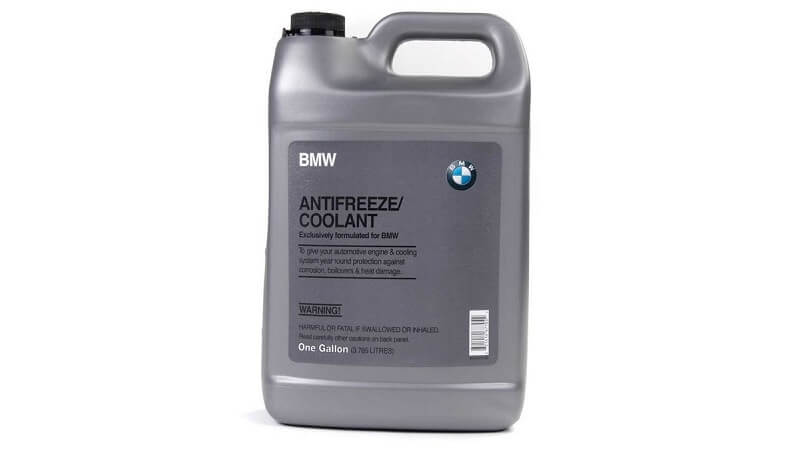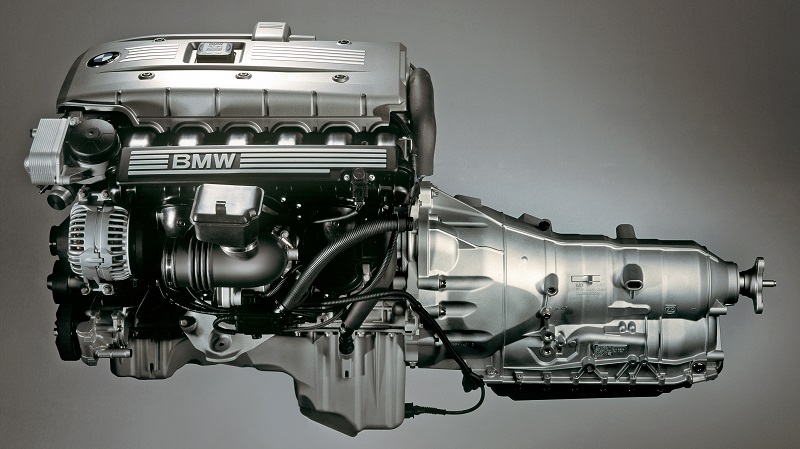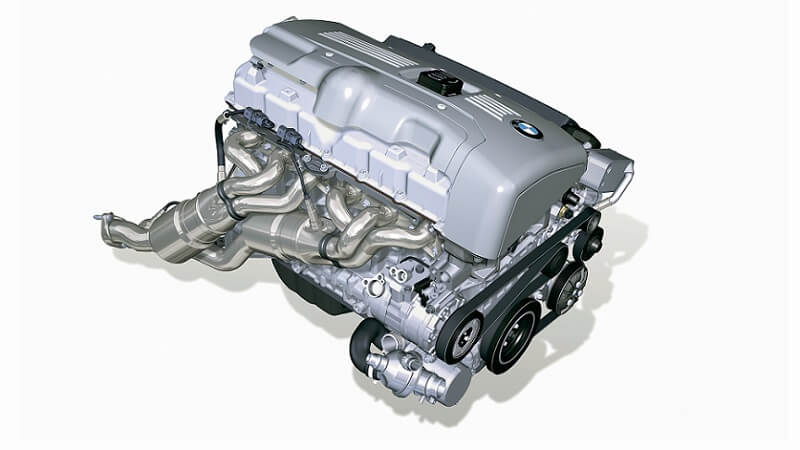In 2008, BMW revealed its first twin-turbo V8 engine ever. The N63 debuted on the E71 X6 and would eventually power multiple models in the German manufacturer’s portfolio, from the 5-Series to the X7 and nearly everything in between.
This is not an engine for everyone. With the heaps of performance that it brought, along came many reliability issues. That said, BMW has addressed a lot of these problems with some significant updates, and the units in production today are a lot more reliable than the BMW N63 engines that came before.
We’ve listed all the available engine versions, along with what you should be looking out for if you’re planning to buy one, new or pre-owned.

Technology Behind The BMW N63 Engine
The N63 was the first production V8 engine to feature a “hot-vee” layout. This is when the turbocharger is placed in between the “V” created by the cylinders. This results in the exhaust manifolds between the cylinder banks, with the intake manifolds located outside — the opposite of what you’d see on a conventional V-engine. The main reason behind doing so is to improve packaging. A hot-vee layout takes up notably less space than a typical turbocharger setup.
There are other benefits like a quicker turbocharger spool time (since the distance the air has to travel is shorter) and better cooling. Speaking of, the turbochargers on the N63 were cooled by two air-to-water intercoolers, resulting in improved performance.
The rest of the engine was similar in construction to other BMW engines of the time. The N63 features an aluminum head with a double overhead camshaft (32 valves in total), VANOS (variable valve timing), and direct injection. BMW didn’t equip the N63 with its variable valve lift or Valvetronic technology for the first few years. However, it was added with the engine’s first technical update (which we’ll look at in more detail) in 2012.
Available Versions

Photo credit: autowp.ru
Early owners of the BMW N63 didn’t have it easy, and if you’re looking at buying one of its earlier iterations, you may have to deal with its unreliable nature as well. However, the good folk at BMW have made multiple alterations over the last 14 years, and the N63 of today is significantly better built. So, what did these many updates entail?
2012 Technical Update
The first update came in 2012, and this iteration of the engine was called the N63B44O1, or the N63TU, where ‘TU’ stood for ‘Technical Update.’ As we mentioned earlier, this update saw the introduction of Valvetronic. While this was the main addition, some other notable updates included a different cylinder head, lighter pistons, revised VANOS system, forged camshaft, connecting rods, and changes to the cooling system.
BMW also removed the drive-by-wire throttle body, which was now unnecessary thanks to the addition of Valvetronic, and introduced a traditional throttle body as a backup. Other minor changes included the addition of new valve stem seals and a revised fuel system that now worked alongside an additional engine management system.
2016 technical update
The N63B44O2, or N63TU2, was the byproduct of a technical update in 2016. Compared to the 2012 update, mechanical changes were minor and aimed to improve cooling and reduce weight.
The most significant change was the addition of twin-scroll turbochargers. BMW also moved the engine oil cooler to within the ‘V’, and placed it underneath the turbos. This simplified the cooling process and allowed the company to remove one radiator. Lastly, the pistons were redesigned to allow more oil to drain back to the pan, reducing how much was pulled back into the combustion chamber.
2018 technical update
The last update for the BMW N63 came in 2018, and this spawned two iterations of the engine — the N63B44M3 and the N63B44T3. The ‘M’ was considered the ‘medium’ engine, while the ‘T’ was the ‘top’ output version.
The N63B44M3 offered better thermal shielding around the cylinder head and crankcase, along with a new ignition system. This engine also came with an overboost feature that allowed for an additional 34hp for a brief period when the car was put in Launch mode.
Meanwhile, the N63B44T3 was equipped with higher pressure injectors and larger twin-scroll turbochargers. Consequently, BMW also redesigned the intake manifold to accommodate the new turbos and tweaked the cooling system.
Which Cars Is The N63 Used on?

BMW made a smaller 4.0L version of the N63 (N63B40A) solely for the Chinese market, but since every N63 sold in the U.S. was a 4.4L unit — 4,395cc to be precise — here’s a look at the cars that it featured on:
N63B44O0
Produced from 2008 up until the first ‘technical update’ went on sale in 2013, the N63B44O0 was the first version of the BMW N63 and powered the following cars:
- 2008-2013 E71 X6 50i
- 2009-2012 F01/F02 750i
- 2010-2011 F07 550i GT
- 2011-2013 F10 550i
- 2011-2013 E70 X5 50i
- 2012 F12 650i
Peak output figures were 402 hp at 5,500-6,400 rpm and 443 lb-ft of torque at 1,750-4,500 rpm, making it the least potent iteration of the engine.
N63B44O1 (N63TU)
The N63B44O1 was produced from 2013 to 2016, producing 444 hp at 5,500-6,000 rpm and 479 lb-ft of torque from 2,000-4,500 rpm.
- 2013-2015 F01/F02 750i
- 2013-2016 F07 550i GT
- 2014-2016 F10 550i
- 2014-2018 F15 X5 50i
- 2014-2019 F16 X6 50i
- 2013-2018 F12/F13 650i
- 2013-2019 F06 650i GC
N63B44O2 (N63TU2)
As we mentioned above, mechanical changes with the second update were relatively minimal, and it didn’t bring about a significant increase in output figures. While peak power and torque figures remained unchanged, the latter was available 200 rpm earlier in the rev band.
- 2016-2019 G12 750i
- 2017-2020 G30 M550i
N63B44M3 (N63TU3)
The lower-spec version of the TU3 engines produced 340 kW 456 hp at 5,250-6,000 rpm and 479 lb-ft of torque at 1,500-4,750 rpm. The engine is still in production and is available on the following:
- 2018-present G05 X5 xDrive50i
- 2018-present G07 X7 xDrive50i
N63B44T3 (N63TU3)
The N63B44T3 is the most powerful iteration of the N63, producing 523 hp at 5,500-6,000 rpm and 553 lb-ft of torque at 1,800-4,600 rpm. It powers multiple BMW models today like the:
- 2018-present G14/G15/G16 M850i xDrive
- 2019-present G11/G12 750i/750Li sDrive/xDrive
- 2020-present G30/G31 M550i xDrive
- 2020-present G05 X5 M50i
- 2020-present G06 X6 M50i
- 2020-present G07 X7 M50i
How Much HP Can a BMW N63 Handle?
The N63 can produce over 600 hp at the wheel with some relatively minor updates, like a larger turbo and improved fueling. Some tuners have also claimed an excess of 700 hp in their dyno runs, and this figure will likely be more common as more people experiment with the platform.
Even in stock form, the BMW N63 is a behemoth of an engine, and tuners have conducted dyno runs where the turbo could handle 25psi of boost. What’s worth noting is that even the older iterations of the engine have a lot of tuning potential, and for just a couple of thousand dollars worth of upgrades, you can push out an excess of 100+hp.
Is the N63 Engine Reliable?

The N63 engines that are being produced today are pretty reliable. Unfortunately, the same can’t be said about the older engine versions. Here are some of the common problems you might encounter with an N63:
Battery Drain
In an effort to increase fuel efficiency, BMW equipped the N63 with a system that involved shutting down the alternator output. Unlike on regular cars, where the battery would charge from the turning of the belts during normal driving, the one on the N63 would recharge only while coasting — foot off the gas and not on the brake. Evidently, this was a counterproductive approach as not too many people with an BMW N63 in their car will find themselves coasting.
BMW tried rectifying the issue by equipping their cars with a larger battery, but this didn’t address the root cause of the problem, and it’s something that owners face even today. As a result, the manufacturer changed the recommended oil service interval from 15,000 miles to 10,000 miles and now throws in a new battery with the service as well.
Excess Oil Consumption
Turbocharged engines typically consume more oil than a comparable naturally-aspirated unit as the turbos also require oil for lubrication and cooling. However, the amount of engine oil that the N63 consumes isn’t normal. Multiple factors contribute to added oil consumption, so it’s a particularly challenging issue to address.
Some of the reported causes of the extra oil being burnt include failure of the piston rings, turbocharger oil seals, crankcase vent hose leaks, or a cracked valve stem seal. A regular BMW engine, such as the widespread N55 series, may consume about a quart of oil every 1,000 miles. Some owners have reported that their N63 went through the same quantity in roughly half the distance!
To try and rectify this, BMW released new valve guides with tighter clearances and offered a free replacement to existing owners. However, this is a labor-intensive task and takes about 12 hours to complete by trained technicians.
Timing Chain Failure
The N63 comprises two timing chains — one for each cylinder bank. On the first version of the engine, they were prone to stretching over time. A stretched timing chain can cause other issues in the valve train and lead to significant drops in performance. Typically, a timing chain should last at least 100,000 miles without needing replacement, but owners of older N63-powered cars were reporting rattling noises from the engine and reduced performance much earlier.
BMW acknowledged an issue and replaced the part (and related components like the timing chain guides and tensioners) on affected vehicles if it wasn’t in the right spec.
Fuel Injector Failure
Even on relatively new engines, there were reports of the fuel injection system failing. Some owners have faced the issue as early as after 20,000 miles. If you’re buying a used N63, try and get it checked by BMW’s diagnostics team at the service center. They should tell you the condition of the fuel injectors and if any (or all) of them have to be replaced. A new injector will set you back a couple of hundred dollars each, so it’s worth getting them checked.
A faulty fuel injector will reduce performance, cause improper idling, and will most likely light up the ‘Check Engine light on the dash.
Leaking Valve Stem Seals
One of the more common problems was with the valve stem seals. The BMW N63 is a substantial piece of engineering, and a larger engine tends to produce more heat. These high-temperature levels caused the valve stem seals to wear out faster than usual.
If this is the case, expect to see large white clouds of smoke from the tailpipe and increased oil consumption. The stem seals themselves are pretty inexpensive, but they’re hard to get to and require some intensive labor that will very likely set you back more than the cost of the part itself.
Water Pump Issues
The BMW N63 has an electric auxiliary water pump that regulates coolant flow to the turbochargers when the engine is off. In the first version of the engine, this water pump would sometimes crack, causing the coolant to leak onto the electronics. Evidently, this can have some severe consequences.
On newer versions of the engine, the water pump would sometimes get blocked. BMW will either replace the pump or the turbocharger itself, depending on how many times your vehicle has been affected by the issue.
What is the BMW N63 Customer Care Package?
As you can see, some of the problems that the N63 brings with it can steer potential buyers away. However, BMW noticed this and released the Customer Care Package (CCP) in late 2014. It was launched to address many of the issues we’ve addressed above and rectify them free of cost. This package covered the timing chain, fuel injector issues, crankcase vent lines, battery draining issues, and low-pressure fuel sensors.
Keep in mind that the CCP only covered 2009-2014 model year vehicles like the ones that followed had most of these issues rectified in production.
Should You Buy An N63-powered BMW Today?
While BMW’s smaller inline-four and inline-six engines have seen some pretty monumental changes over the last decade, the venerable BMW N63 remains essentially unchanged. With the advent of electric vehicles and BMW’s increased focus on more sustainable powertrains, it’s unlikely that the manufacturer has another V8 engine in the pipeline. That means the N63 could very well be the last of its kind from the Bavarians.
The reliability of it is something you should definitely consider, but with the Customer Care Package covering the older versions and the newer N63s being much more reliable off the production line, now is as good a time as any to get your hands on one. That said, since it’s an engine that’s still in production, prices for even a pre-owned version can be pretty steep, and you may be better off waiting for a couple of years if you want to save some money.







Very informative article! Thank you. I have a used 2012 750Li. Purchased it at over 100k miles. White smoke from tail pipe and excessive oil consumption. Do you think BMW’s Customer Care Package would cover these issues for me, and if so, how do I get a CCP plan from BMW?
Hi Thomas,
It’s been a while since BMW ran the CCP program for the N63. That being said, the package should technically address your issues, if you can still get it. I suggest you give BMW USA’s toll-free line a call at 1-800-831-1117 and asking them directly.
Mark
Thomas, did you get a response back from BMW USA? If so, what info did they give you?
Great write up, thank you so much!
Thank you for the information. I have a 2019 g15 or m850i that has an ECU E30 custom tune that makes over 700 horsepower on the tire. So far the car has been extremely reliable and no issues whatsoever and the car has ran a 10.51 at 134 mph on a drag strip with a DA of 2550. Also will hit 164 in a half mile. Very impressed with this platform.
I am thinking of purchasing a 2013 BMW X5 with a 4.4 engine which does not run. The owner says it only has 31,00 miles. Can this engine be rebuilt successfully considering the problems you mentioned above. Could this engine be replaced with a 3.5 V6 version(engine used in the 40i series)I don’t really care about loosing the HP.